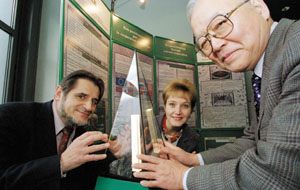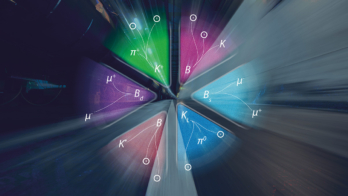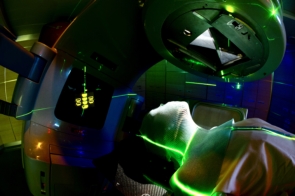The Cold War once absorbed a tremendous amount of resources and talent on both sides of the Iron Curtain. Particle physics is now at the forefront of a major, international effort that is refocusing these resources in more profitable directions.

Non-proliferation through scientific co-operation is the mission statement of the International Science and Technology Centre. The centre was established in 1992 under an agreement between the European Union, Japan, the Russian Federation and the US. Since 1992, other member nations have joined: Norway, Korea, Armenia, Belarus, Georgia, Kazakstan and Kirgizstan.
Based in Moscow, the International Science and Technology Centre (ISTC) provides ex-weapons scientists from former Soviet Union (FSU) countries with the opportunity to refocus their talents on peaceful activities. These activities may include helping to solve national and international technical problems; supporting the transition to market-based economies; contributing to basic and applied research; and encouraging the integration of other former weapons scientists into the international scientific community.
In the years 1992-9, ISTC programmes funded 830 projects worth US$230 million, providing grant payments to more than 30 000 workers. Particle physics and CERN played a valuable role in bringing together scientists and promoting understanding during the Cold War, and this role is continuing in the ISTC.
The main thrust of the ISTC programme is to support projects for FSU centres in collaboration with foreign firms or organizations. A significant proportion of the funding comes from ISTC sources. Each project is assigned to a CERN-familiar Russian “lead institute”, which acts as a gateway to a frequently unfamiliar new supplier.
This traditional ISTC programme was extended in 1997 by the Partnership Programme, under which western organizations fund research and development to be conducted on their behalf at FSU centres via the ISTC. In this framework the outside funding is channelled by the ISTC, which also provides the necessary infrastructure and management inside the FSU region.
Overall, Partnership Programme contracts now exist with almost 60 partners, who work in the electrical, biomedical and chemical industries, as well as at research centres such as CERN. ISTC director-general Alain Gérard declared: “CERN-ISTC co-operation in high-energy physics continues to be a shining example of the unique and effective nature of the Partnership Programme, and it is a model for our future activities with CERN and other FSU institutes.”
The ISTC “business”, under both the traditional ISTC activities and thePartnership Programme, represents only a fraction of the total CERN-Russia collaboration. However, it signficantly extends its involvement to include additional institutes and a wider pool of expertise.
Case-studies
One of the first major projects under the ISTC banner began in 1994. This was a feasibility study of technologies for the accelerator-based conversion of plutonium and long-lived radioactive waste.
The Russian lead institute was Moscow’s Institute for Theoretical and Experimental Physics (ITEP), with six other Russian centres also being involved. The partners were CERN and the US Los Alamos National Laboratory, both of which have demonstrated the feasibility of using particle beams from accelerators to transmute weapons grade plutonium and to reprocess nuclear waste.
Directly involved in CERN’s mainstream programme of research was an ISTC project for the design and construction of a cryostat and vacuum windows for a large liquid krypton calorimeter. The calorimeter is a key element of the NA48 CP violation experiment, which recently announced its initial results. Arranged through the Joint Institute of Nuclear Research (JINR) in Dubna, Moscow, the project involved the Khrunichev State Space Science and Production Centre, and ENTEK in Moscow. INFN Pisa was also a major partner.
Development work for experiments at CERN’s future LHC collider is the theme of several major ISTC projects. Special computer systems to facilitate LHC detector design is the goal of VNIITF in Snezhinsk, with JINR also being involved. Recently the Snezhinsk institute assumed responsibility for the construction of major support structures for the ATLAS experiment, also involving JINR Dubna, IHEP Protvino and MPI Munich.
The inner tracker and forward multiplicity detector (FMD-MCP) for the ALICE experiment at CERN involves TsKBM of St Petersburg as the lead institute, together with JINR; the Nuclear Physics Institute in Gatchina, St Petersburg; the Kurchatov Research Centre, Moscow; the Mendeleev Institute of Metrology, St Petersburg; and several other St Petersburg concerns, as well as the university. On the CERN side, INFN Ferrara and Utrecht University provide the main interface.
For CMS, the production of lead tungstate crystals for the electromagnetic calorimeter was investigated by the Bogoroditsk Techno-Chemical plant. After this pilot study, mass-production of the 80 000 crystals will be shared by the Bogoroditsk plant and the Shanghai Institute of Ceramics.
For the endcap of the ATLAS hadron calorimeter, the main Russian partner is the Institute of High-Energy Physics (IHEP) in Protvino, Moscow, which is working with NPO Molniya of Moscow. The main collaborators are the Max-Planck Institut in Munich and CERN.
Several items for LHC detectors involve mass-production, such as the injection moulding for 0.5 million 200 x 400 mm transparent scintillation tiles to clad the ATLAS hadron calorimeter. IHEP in Protvino is the main Russian coordinator, with two specialist Russian concerns. For ATLAS, the project is handled by the Laboratorio de Instrumentaçao e Fisica Experimental de Particulas, Lisbon.





